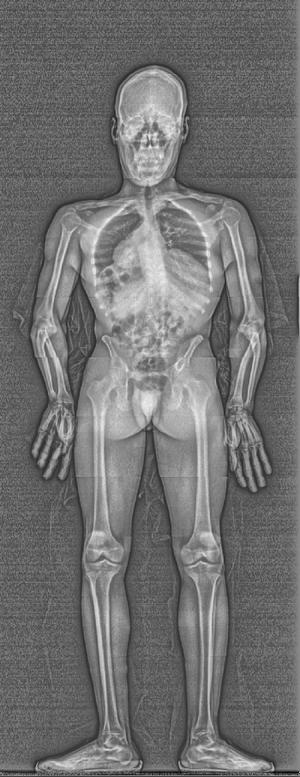Screening technologyRadPRO SecurPASS from Virtual Imaging
As worries about security increase, more venues require employees, customers, and visitors to pass through security scans; the scanning machines at the growing number of security check-points must meet two criteria: they should be able to detect a wide variety of materials and objects, and should do so at the lowest radiation dose possible; Virtual Imaging, a wholly owned subsidiary of Canon U.S.A., Inc., says its RadPRO SecurPASS meets these two criteria

Image generated by the RadPRO SecurPASS // Source: Virtual Imaging
The definition of what constitutes a dangerous material changes with the context and circumstances. A liquid which you will not give a second look to at home becomes a potential bomb material when carried on board. Commonplace materials such as copper wire or a pair of scissors become potential weapons when smuggled into a prison.
As worries about security increase and concerns with safety grow, more and more venues want to know — and more and more often, are required by law to know — what employees, customers, and visitors bring with them. The “visit” may not always be voluntary, as when defendant enters a court room, or a prisoner returns from a visit with his family in the visitation room.
This requirement by more and more venues of learning more about what employees, customers, or visitors bring with them — on or inside their bodies — must be balanced against the potential risk to health of exposure to radiation.
Screening technologies
Two types of X-ray scanning systems currently exist for security screening of individuals: backscatter systems and transmission systems.
Backscatter systems. With backscatter systems, the X-rays do not penetrate to depths much beyond the surface of the individual, so these systems are useful for imaging objects hidden under clothing, but are not useful for detecting objects hidden in body cavities. Backscatter systems are currently being used in the United States by the Customs Service and by several prisons for interdiction of drugs, weapons, and contraband.
A typical scan lasts about eight seconds and results in an effective dose of approximately 0.03 microsievert (μSv) to the individual.
Transmission systems. With transmission systems, the X-rays traverse through the body, similarly to a medical X-ray, so that objects that have been swallowed or hidden in body cavities may be visible. At least one model of a transmission scanning system is currently used outside the United States to screen workers exiting mines (for example, diamond mines) and at customs checkpoints in lieu of invasive body-cavity inspection.
Subjects being scanned move through the beam in approximately eight seconds and the effective dose per scan is on the order of 0.25 to 2.0 μSv.
Other technologies. Presently, there are also security scanners for the inspection of trucks, sea containers, train cars, or other cargo containers that use either gamma rays emitted by a radionuclide (for example, 137Cs or 60Co) or machine-generated radiation (for example, X-rays or neutrons). These systems are not intended to expose human
